Underneath a transcript of the talk I gave at the Norlit 2015: The Book to Come conference, which took place August 20-22 at Goteborg University. In it I outline the contours for a new research project on ‘visions of the future book’. The PP accompanying this talk can be accessed here.
I want to share some work in progress about a research project I have recently embarked upon. Partly this project is focused on mapping future visions of the book through the ages, to explore how these kinds of prognoses and discourses have been integral to the material becoming of the book, and vice versa. This includes predictions of the book of the future as explored in literature, scholarship (including book history and literary studies), film, science fiction, journalism, the publishing industry and what have you. Book history and increasingly also media studies have focused on the material aspects of the book, as well as on the book’s cultural context and situatedness. Up until now however, there has been a lack of research on how the discourses surrounding the past and future of the book (which includes book history itself) and the material and cultural becoming of the book have interacted and are entangled as part of the book’s development.
 As I will argue, future visions of the book have been incremental in setting out the contours or the framework in which we were and are able to imagine a future for the book, and as such have been an essential part of the book’s becoming. At the same time these predictions have emerged from certain settings and contexts, related to established practices, power structures and technological developments, which have enabled specific kinds of visions to emerge. The book arises and continues to develop out of this entanglement.
As I will argue, future visions of the book have been incremental in setting out the contours or the framework in which we were and are able to imagine a future for the book, and as such have been an essential part of the book’s becoming. At the same time these predictions have emerged from certain settings and contexts, related to established practices, power structures and technological developments, which have enabled specific kinds of visions to emerge. The book arises and continues to develop out of this entanglement.
What kind of assumptions about the nature of the book do these visions entail? My premise will be that the various book futurist perspectives are closely connected to how we continue to think the book itself. Hence they tend to follow and consolidate the outlines of a hegemonic framework, constituted by established stakeholders and practices, which determines what a book is and hence what its future could be. I will more closely describe this framework shortly.
 The predominant aim of my research is to explore how this framework itself can be rethought, following a feminist interventionist and media archaeological perspective. I want to do so by exploring future visions of the book that either do not conform to or have critiqued this hegemonic framework structuring how we think the book. In what sense have these predictions challenged what a book is and can become, by explicitly speculating about an alternative future for the book? By drawing out connections from these ‘counter-hegemonic’ or disruptive visions, I want to explore and experiment with a divergent, speculative framework for the book to come, in an attempt to think this framework differently, whilst taking responsibility for the impact and situatedness of my own performative discourse.
The predominant aim of my research is to explore how this framework itself can be rethought, following a feminist interventionist and media archaeological perspective. I want to do so by exploring future visions of the book that either do not conform to or have critiqued this hegemonic framework structuring how we think the book. In what sense have these predictions challenged what a book is and can become, by explicitly speculating about an alternative future for the book? By drawing out connections from these ‘counter-hegemonic’ or disruptive visions, I want to explore and experiment with a divergent, speculative framework for the book to come, in an attempt to think this framework differently, whilst taking responsibility for the impact and situatedness of my own performative discourse.
For this talk in specific I want to shortly give an overview of the different future visions of the book I have identified and mapped up to now, giving short examples to illustrate the various future perspectives and prognoses. As this is very much a work-in-progress, any additions or suggestions are more than welcome. With this mapping exercise I am not aiming to construct a model or to pin-down divergent discourses, I am mostly interested in establishing associations and in making underlying epistemological assumptions and relationships visible. Based on this mapping I will set out and at the same time critique the underlying framework that tends to structure the unfolding book. Within the limitations of this framework, what kinds of possibilities are there for us to rethink it, and to intervene? To start to engage with these alternative speculative futures, I will draw on current media studies, book history, literary studies and feminist new materialist research that either tries to rethink the assumptions on which this framework is build, or the framework as it relates to speculative futurism itself. At the end of my talk I will show how the book, as a nodal point between discourse and matter, time and space, forms an excellent point to explore different futures for knowledge production and communication.
 Let me first walk you quickly through some of the future visions of the book I have identified up to now.
Let me first walk you quickly through some of the future visions of the book I have identified up to now.
1. The most well-known book futurist perspective might be a dystopian one, one in which the book will or has become obsolete due to technological progress. This ‘death of the book’ meme is longstanding, and has existed for more than 500 years as it emerged with the coming of newspapers, the radio, television, CD-roms etc., and is ever popular in current narratives on digitisation and the rise of the ebook, which have launched evermore eulogies for the printed book.
 2. On the other hand, one of the most common utopian visions is that of the universal library, where all the books or all information in the world will be kept and stored in one place. This can either be a vast or infinitely expansive place such as the Library of Alexandria or Borges Library of Babel, or a more compressed space such as Paul Otlet’s Mundaneum, or even more concentrated: canned libraries and handheld mobile devices.
2. On the other hand, one of the most common utopian visions is that of the universal library, where all the books or all information in the world will be kept and stored in one place. This can either be a vast or infinitely expansive place such as the Library of Alexandria or Borges Library of Babel, or a more compressed space such as Paul Otlet’s Mundaneum, or even more concentrated: canned libraries and handheld mobile devices.
3. Another well-known future vision is that of the multimodal book in which the book will be able to incorporate different kinds of new media next to or instead of its textual content. Multimodal books can include everything from pictures to videos and audio content (exemplified in Paul Otlet’s predictions of the ‘televised book’ for example), but also multi-layered gis-maps, interactive documents or even augmented reality material in which books are seen to ‘come alive’.
4. The social book has also been highly anticipated, as part of visions in which the distinction between author and reader and between writing and reading is seen to disappear due to technological advances in annotating, hyperlinking, interactive hypertexts, wiki books, collaborative editing etc. Here the notion of a universal conversation between networked books and people is predominant. This vision is also noticeable in narratives on the death of the author and the birth of the reader for example.
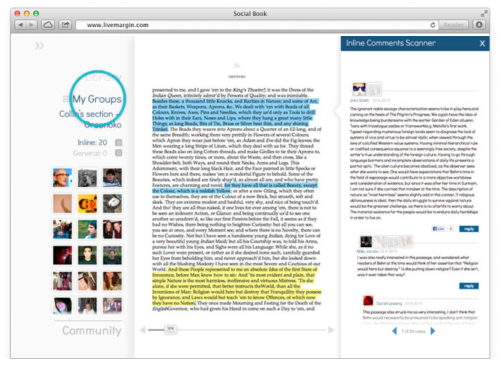 5. The open book is a very interesting political and ethical vision of the book to come, one that is very critical of the current copyright and ownership regime of books. In this vision books will have no copyright boundaries in the future, there will be total access to all digitised content, all information can be data-mined and reused and so on. Open books are also envisioned to be less ‘fixed’, where different versions could be published as books-in-progress.
5. The open book is a very interesting political and ethical vision of the book to come, one that is very critical of the current copyright and ownership regime of books. In this vision books will have no copyright boundaries in the future, there will be total access to all digitised content, all information can be data-mined and reused and so on. Open books are also envisioned to be less ‘fixed’, where different versions could be published as books-in-progress.
 6. The posthuman book capsulated a range of interesting visions, from predictions of machines or animals writing or reading books (including the important question whether robots will be able to write novels as they have for instance already become journalists), or of books writing themselves (this echoes current developments in FLARF and automated poetry). A good example of a non-book and non-human writing and storage device is provided by Christian Bok’s Xenotext experiments in which he encodes a poem into the DNA of a bacterium, which then becomes a machine for writing a poem in response.
6. The posthuman book capsulated a range of interesting visions, from predictions of machines or animals writing or reading books (including the important question whether robots will be able to write novels as they have for instance already become journalists), or of books writing themselves (this echoes current developments in FLARF and automated poetry). A good example of a non-book and non-human writing and storage device is provided by Christian Bok’s Xenotext experiments in which he encodes a poem into the DNA of a bacterium, which then becomes a machine for writing a poem in response.
7. The Post-Digital book is a quite recent, almost retro vision which envisions the book to come as a move back to print and older obsolete media, due to the increasing surveillance and tracking of information production, exchange and consumption in digital environments, among others. But it also connects to the trend in book publishing towards luxury printed objects, and a move within art and design towards craft and materiality, with a focus on hand-made artist books, self-publishing and hipster publishing.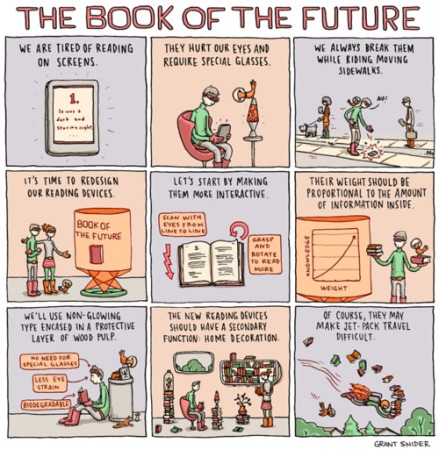 If we analyse these visions more in depth we can see most of them tend to harbour and reinstate certain preconceptions about the book and about the future of information, and I will again discuss these quickly here.
If we analyse these visions more in depth we can see most of them tend to harbour and reinstate certain preconceptions about the book and about the future of information, and I will again discuss these quickly here.
 1. First of all we can see that they tend to be based on and play out a lot of rather limited dualisms or binaries; of utopias and dystopias, death and living, fixed and closed, open and fluid books for example; and, following Tim Carmody and Joanne McNeill’s terminology, they tend to predominantly sway between technofuturist and bookservatist visions.
1. First of all we can see that they tend to be based on and play out a lot of rather limited dualisms or binaries; of utopias and dystopias, death and living, fixed and closed, open and fluid books for example; and, following Tim Carmody and Joanne McNeill’s terminology, they tend to predominantly sway between technofuturist and bookservatist visions.
2. Secondly, most forecasts tend to be teleological seeing the book as progressing to either a new mode or a technologically advanced level, or as becoming obsolete due to technological advancements. This investment in linearity is also apparent in the death of the book meme, where media are seen to replace each other, and in the move towards digitisation, where in some cases ‘old’ media are even destroyed as part of the digitisation project (which is often seen as a superior technology).
3. Thirdly, there tends to be an object-based focus: the book mostly remains a ‘thing’, a fixed object with clear boundaries, a standardised product and marketable commodity with an author-producer and a market of readers which plays an important role in the ever growing international literary book trade and the scholarly publishing conglomerate. This object-based focus is naturally one that remains strong in industry predictions of the future book.
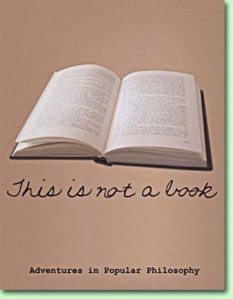 4. Fourthly, most visions also seem to hold on to a fixed idea or definition of what a book is, which remains mainly based on the codex or the scroll, or focuses on the book as a container, a binding, gathering and storing devise. This predetermined idea of what a book is also extends to its context, where future visions of the book still tend to incorporate authors, readers and libraries for example.
4. Fourthly, most visions also seem to hold on to a fixed idea or definition of what a book is, which remains mainly based on the codex or the scroll, or focuses on the book as a container, a binding, gathering and storing devise. This predetermined idea of what a book is also extends to its context, where future visions of the book still tend to incorporate authors, readers and libraries for example.
5. Fifthly, these predictions also tend to put forward specific, often rather simplistic visions of time, history and the ‘now’; they are mostly forward-looking, not reconnecting to the past for example, and do usually not provide room for more complex ways of understanding time as a contested process of iteration and transformation. The book simply tends to be mapped on a linear and flat notion of time.
6. Sixthly, most of these visions are representational, where their ‘prophets’ tend to position themselves above or outside the context or future they actually reflect upon; their visions tend to be descriptive, not practical, experimental or performative interventions. For example think of Barthes reflections on the death of the author, which where published in a conventionally authored and published book, or of the plethora of books and articles arguing for open access to scholarly works, which are nonetheless published behind paywalls or by commercial publishers.
What I am interested in instead, in an effort to move beyond these preconceptions, is to explore and experiment with more speculative futures, ones that are less predetermined and prescriptive and leave the question of what the book is open; open to change and to the inherently changing materiality of the book. These rather focus on the evolving material-discursive becoming of the book, within certain political and ethical contexts. These alternative predictions aim to move beyond simplistic binaries and object-thinking, challenging separations between us and the book and its context, where we as book historians and literary theorists, with our narratives and critiques are integral to the book’s becoming. In these prognoses there is no simple before or after scenario for the book – no solution for innovation but rather an ongoing prospect for intervention and experimentation.
 To start imagining what such an alternative framework might entail, I would like to turn to three thinkers who have critiqued the existing framework and specifically the spatio-temporal embedding of the book within book historical discourses. How can these critiques help us to devise more speculative perspectives for the book to come?
To start imagining what such an alternative framework might entail, I would like to turn to three thinkers who have critiqued the existing framework and specifically the spatio-temporal embedding of the book within book historical discourses. How can these critiques help us to devise more speculative perspectives for the book to come?
First of all, literary theorist Rachel Malik offers a valuable critical perspective to the hegemonic framework structuring future visions of the book. In an attempt to challenge the tendency in contemporary book and history studies to put the book as an object in the centre of its investigations, Malik gives central stage to publishing, perceived as a set of ongoing processes, practices and relations, instead. The book, reconceived as part of this more processual and relational framework, then becomes a site to explore the relations between fixing and unfixing in publishing and knowledge production. By moving from a framework focused on products and actors towards processes and agentic relations, Malik thus wants to both emphasise and rethink the temporal relations in publishing and writing. So conceived, the book or the edition is no longer merely the material form that the reader encounters but a site where publishing practices intersect, she states. Similarly publishing is not merely a teleological step towards a publication, mediating between the author and readers or markets. Rather publishing is something that precedes this, governing and constituting what can be published, written, and read within a particular historical moment, structured by what Malik calls ‘horizons of the publishable’. Instead of putting the book at centre point Malik thus wants to explore what the conditions are under which knowledge is created and circulated (or not) in specific contexts. Horizon then denotes both a boundary or a limit and the conditions of possibility. The book (or the edition), reconceived in this way, is not a constraint or a fixed boundary, Malik argues, but it becomes a site, a nodal point where various publishing processes—writing, editing, design, marketing, production—intersect and conflict.
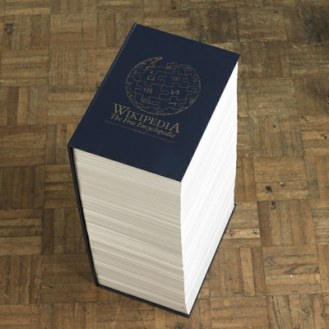 Johanna Drucker has also recently made a plea to rethink the temporalities of publishing, again related to the object-centred approach lying at the heart of book history. Where Malik rethinks this temporality through the process of publishing, Drucker destabilizes the book object itself through her notion of the ‘conditional document’. Similarly to Malik, Drucker conceives of the book as a distributed object, not a thing, but ‘a set of intersecting events, material conditions, and activities’. Following a new materialist performative understanding of materiality, Drucker redefines books as event spaces within, as she states, ‘an ecology of changing conditions’, where an object emerges from the co-dependent conditions in which it appears. As Drucker makes clear, temporality defines documentality in these conditional circumstances, as a document emerges from conditions whose relation to each other is temporal. A document is thus not a static thing or a being, but always ‘in a condition of “becoming”’. Drucker specifically condemns hegemonic object-based bibliographical models as being western-based frameworks, which have a limited capacity to deal with ‘alterity’. She suggests a decolonising approach, following Mignolo, which, as she states, cannot simply be accomplished by extending the existing epistemologies to include “other” objects. Instead it has to begin with dismantling the foundations of these epistemologies and it will need to rebuild them with the full field of objects/practices, and conditional temporal relations in view. Bibliography and book history, in their future formulations, Drucker emphasises, will have to contend with these changed conditions. The distributed character of the document includes distribution across space(s) and temporalities, and is not autonomous in this respect. So here we can see clearly how both Drucker and Malik argue for a different understanding of the past and future of the book through a reframing of the hegemonic discourse on book history (envisioned as western, object-based, teleological) that determines our understanding of the book, emphasizing the close relationship between our discourses and our understanding of the book’s materiality.
Johanna Drucker has also recently made a plea to rethink the temporalities of publishing, again related to the object-centred approach lying at the heart of book history. Where Malik rethinks this temporality through the process of publishing, Drucker destabilizes the book object itself through her notion of the ‘conditional document’. Similarly to Malik, Drucker conceives of the book as a distributed object, not a thing, but ‘a set of intersecting events, material conditions, and activities’. Following a new materialist performative understanding of materiality, Drucker redefines books as event spaces within, as she states, ‘an ecology of changing conditions’, where an object emerges from the co-dependent conditions in which it appears. As Drucker makes clear, temporality defines documentality in these conditional circumstances, as a document emerges from conditions whose relation to each other is temporal. A document is thus not a static thing or a being, but always ‘in a condition of “becoming”’. Drucker specifically condemns hegemonic object-based bibliographical models as being western-based frameworks, which have a limited capacity to deal with ‘alterity’. She suggests a decolonising approach, following Mignolo, which, as she states, cannot simply be accomplished by extending the existing epistemologies to include “other” objects. Instead it has to begin with dismantling the foundations of these epistemologies and it will need to rebuild them with the full field of objects/practices, and conditional temporal relations in view. Bibliography and book history, in their future formulations, Drucker emphasises, will have to contend with these changed conditions. The distributed character of the document includes distribution across space(s) and temporalities, and is not autonomous in this respect. So here we can see clearly how both Drucker and Malik argue for a different understanding of the past and future of the book through a reframing of the hegemonic discourse on book history (envisioned as western, object-based, teleological) that determines our understanding of the book, emphasizing the close relationship between our discourses and our understanding of the book’s materiality.  Katherine Hayles, from a temporal-spatial perspective, also places the book as a nodal point in a dynamic of expansion and compression in a recent talk at The Total Archive conference in Cambridge. Here she reflected on two different visions of the future book related to the total archive, first of all the image of the universal library exemplified in Borges story the Library of Babel, and secondly the image of future book as an infinite compression—such as perceived in Borges story The Aleph, but also in visions of handheld libraries or in contemporary digitisation scenarios. As Hayles made clear these two visions are not opposites, but instead cycle continuously trough each other, like a Mobius strip, and flip into each other. The book is the nodal point then where and when these visions of the total archive are mediated by a hinge. At this inflection point from compression to expansion, the book emerges. However, this is also the point, Hayles points out, where the apparatuses of control (institutions, governments, corporations, universities, publishers), which mediate between this change between compression and expansion, between fixing and unfixing, and processes and objects, are situated. Hayles clearly shows here how these apparatuses or conglomerates of control use the book to fix knowledge production and to regulate the spatio-temporal context of information exchange. In this respect the book also becomes the nodal point between what we perceive the future and past to be, delimiting this future and past as fixed points on a linear scale, with the book and its stable forms of knowledge gathered in between. Re-imagining the book, book history and the discourses on the future of the book, might therefore aid us in envisioning a more complex temporal milieu, in which time is plural and multiple ideas of the future exist side-by-side.
Katherine Hayles, from a temporal-spatial perspective, also places the book as a nodal point in a dynamic of expansion and compression in a recent talk at The Total Archive conference in Cambridge. Here she reflected on two different visions of the future book related to the total archive, first of all the image of the universal library exemplified in Borges story the Library of Babel, and secondly the image of future book as an infinite compression—such as perceived in Borges story The Aleph, but also in visions of handheld libraries or in contemporary digitisation scenarios. As Hayles made clear these two visions are not opposites, but instead cycle continuously trough each other, like a Mobius strip, and flip into each other. The book is the nodal point then where and when these visions of the total archive are mediated by a hinge. At this inflection point from compression to expansion, the book emerges. However, this is also the point, Hayles points out, where the apparatuses of control (institutions, governments, corporations, universities, publishers), which mediate between this change between compression and expansion, between fixing and unfixing, and processes and objects, are situated. Hayles clearly shows here how these apparatuses or conglomerates of control use the book to fix knowledge production and to regulate the spatio-temporal context of information exchange. In this respect the book also becomes the nodal point between what we perceive the future and past to be, delimiting this future and past as fixed points on a linear scale, with the book and its stable forms of knowledge gathered in between. Re-imagining the book, book history and the discourses on the future of the book, might therefore aid us in envisioning a more complex temporal milieu, in which time is plural and multiple ideas of the future exist side-by-side.
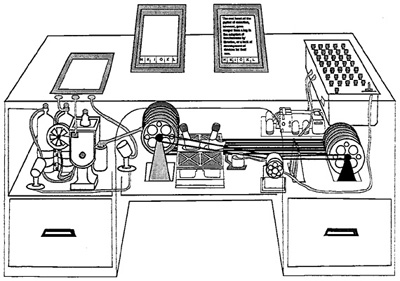
Reblogged this on Litetuga.